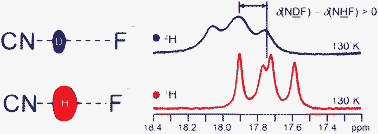H/D isotope effects on NMR chemical shifts of nuclei involved in a hydrogen bridge of hydrogen isocyanide complexes with fluoride anion
Abstract
1
H, 2H,

* Corresponding authors
a V. A. Fock Institute of Physics, St. Petersburg State University, Uljanovskaja 1, St. Petersburg, Russia
b
Institute of Chemistry and Biochemistry, Free University of Berlin, Takustr. 3, Berlin, Germany
E-mail:
tolstoy@chemie.fu-berlin.de
Fax: +49 30 838 55310
Tel: +49 30 838 53615
1
H, 2H,

 Please wait while we load your content...
Something went wrong. Try again?
Please wait while we load your content...
Something went wrong. Try again?
N. S. Golubev, C. Detering, S. N. Smirnov, I. G. Shenderovich, G. S. Denisov, H. Limbach and P. M. Tolstoy, Phys. Chem. Chem. Phys., 2009, 11, 5154 DOI: 10.1039/B900152B
To request permission to reproduce material from this article, please go to the Copyright Clearance Center request page.
If you are an author contributing to an RSC publication, you do not need to request permission provided correct acknowledgement is given.
If you are the author of this article, you do not need to request permission to reproduce figures and diagrams provided correct acknowledgement is given. If you want to reproduce the whole article in a third-party publication (excluding your thesis/dissertation for which permission is not required) please go to the Copyright Clearance Center request page.
Read more about how to correctly acknowledge RSC content.
 Fetching data from CrossRef.
Fetching data from CrossRef.
This may take some time to load.
Loading related content
